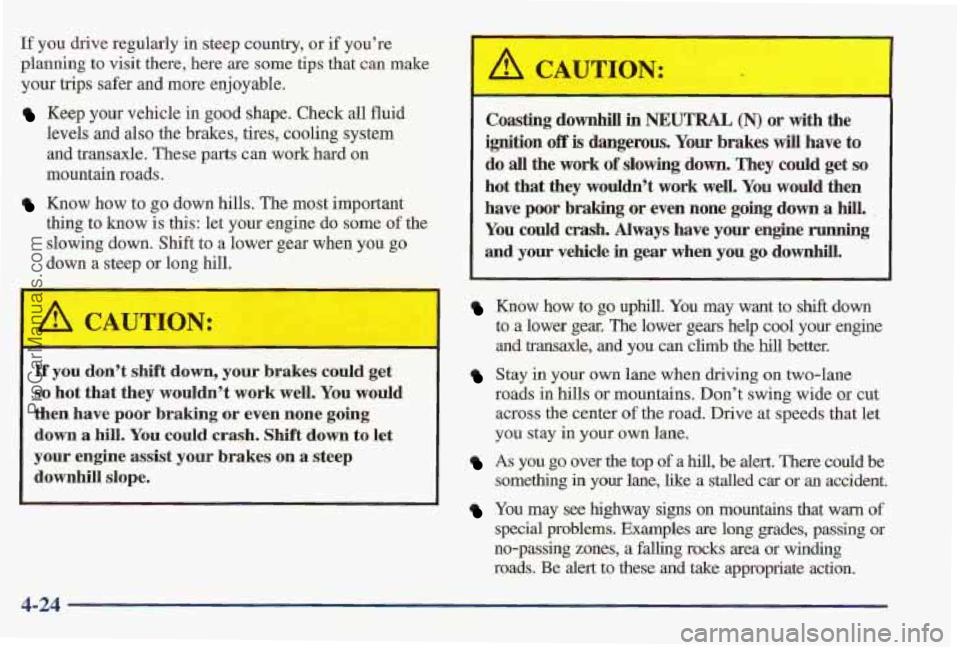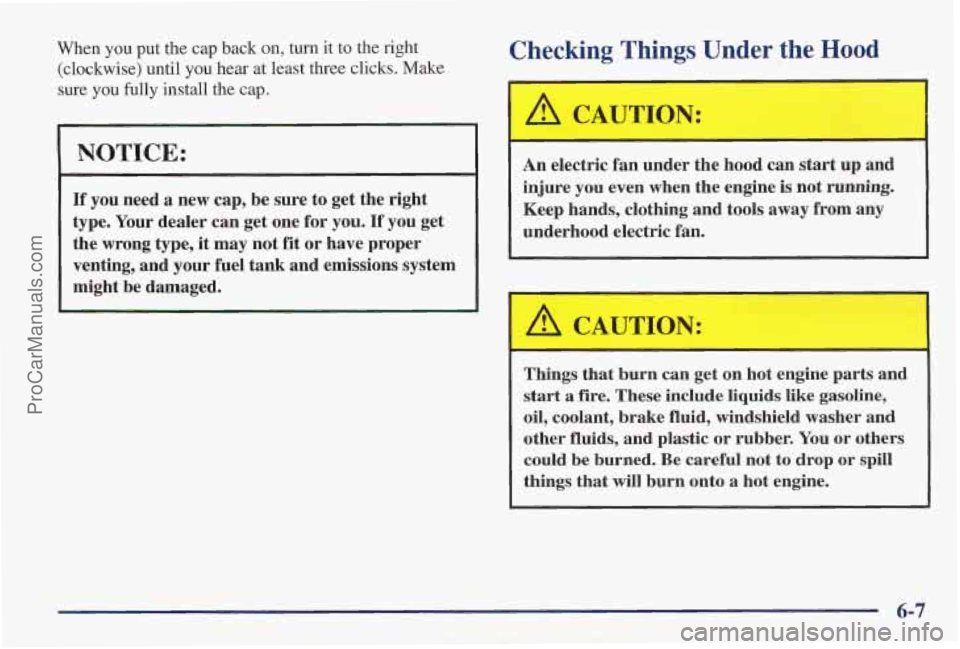1997 PONTIAC PONTIAC brake fluid
[x] Cancel search: brake fluidPage 75 of 419

v Section 2 Features and Controls
Here you can learn about the many standard and optional features on your Pontiac, and information on starting,
shifting and braking. Also explained are the instrument panel and the warning systems that tell you if everything is
working properly
-- and what to do if you have a problem.
2-2
2-4
2-8
2- 10
2-12
2-15
2-15
2- 16
2-18
2-19
2-24
2-29
2-30
2-3 1
Important Information About Keys
Door Locks
Remote Keyless Entry Battery Replacement for RKE
Preventing Theft
of Your Vehicle
New Vehicle “Break-In”
Ignition Positions
Tips on Starting Your Engine
Using the Engine Coolant Heater
Automatic Transaxle Operation
Parking Brake Guidelines
Important Information on Engine Exhaust
Operation of Your Windows
Adjusting the Tilt Steering Wheel 2-32
2-33
2-33
2-35
2-3 8
2-39
2-40
2-5 3
2-54
2-62
2-64
2-78
2-83
Functions of the Multifunction Lever
How to Use the HighLow Beam
Headlamp Changer
Windshield Wipers and Fluid
Using Cruise Control
Exterior Lamps
Daytime Running Lamps
(DRL)
Interior Lamps
Rearview Mirrors
Storage Compartments
Instrument Panel Overview
All About Your Warning Lights and Gages
Driver Information Center
Head-Up Display
2-1
ProCarManuals.com
Page 153 of 419

Functions
CHANGE OIL SOON: This light will appear when the
system predicts that the oil’s remaining useful life
is
almost up. The system predicts remaining oil life using
inputs from length of drives, coolant temperature,
engine rpm, and vehicle speed. It alerts you to change
the oil on a schedule consistent with your vehicle’s driving conditions.
To reset your change oil soon system after an oil change,
turn the key to the
ON position, without the engine
running and pump the accelerator
3 times within
5 seconds.
LOW WASHER FLUID: This light will come on when
your ignition is on and the fluid container is low.
CHECK TIRE PRESS: This light alerts you that a tire
is low or flat. See “Check Tire Pressure Light” in
the Index.
TRUNK A JAR: This light alerts you that your trunk is
not fully closed.
DOOR AJAR: If one of your doors is left ajar, a light
will appear next to that door on the vehicle outline.
TRAC SWITCH: If your vehicle has the Trac System
(this is not available with the
3800 Supercharged
engine), you will have
a disable switch on the far right
side of your Driver Information Center.
Your Trac
System is automatically activated when you turn the
ignition on. This switch will activate/deactivate the Trac
System.
If you need to disable the system, such as when
you
are stuck and are rocking your vehicle back and
forth, push this switch. See “Stuck: In Sand, Mud, Ice or
Snow” in the Index.
LOW TRAC: This light will come on when your Trac
System is limiting wheel spin or when your anti-lock
brake system
is active. See “Trac System” or “Low
Traction Light” in the Index.
2-79
ProCarManuals.com
Page 212 of 419

The heavier the rain, the harder it is to see. Even if your
windshield wiper blades are in good shape, a heavy rain
can make it harder to see road signs and traffic signals,
pavement markings, the edge
of the road and even
people walking.
It’s wise to keep your windshield wiping equipment
in good shape and keep your windshield washer tank
filled with washer fluid. Replace your windshield wiper
inserts when they show signs
of streaking or missing
areas on the windshield, or when strips
of rubber start to
separate from
the inserts. Driving
too fast through large water puddles
or even
going through some car washes can cause problems, too.
The water
may affect your brakes. Try to avoid puddles.
But if you can’t, try to slow down before you hit them.
Wet brt L c% le accidents. They won’t work
as well
in a quick stop and may cause pulling to
one side.
You could lose control of the vehicle.
After driving through a large puddle of water or
a car wash, apply your brake pedal lightly until
your brakes work normally.
4-18
ProCarManuals.com
Page 218 of 419

If you drive regularly in steep country, or if you’re
planning
to visit there, here are some tips that can make
your
trips safer and more enjoyable.
Keep your vehicle in good shape. Check all fluid
levels
and also the brakes, tires, cooling system
and transaxle. These
parts can work hard on
mountain roads.
Know how to go down hills. The most important
thing
to know is this: let your engine do some of the
slowing down. Shift to
a lower gear when you go
down
a steep or long hill.
If you don’t shift down, your brakes could get
so hot that they wouldn’t work well. You would
then have poor braking or even none going
down
a hill. You could crash. Shift down to let
your engine assist your brakes
OIJ a,qteep
downhill slope. I ,. +;‘ . ..
<,r:. ,. . I .’ I ; ..:, .h.=;. 2-l:.
.. . .,
I
Coasting downhill in NEUTRAL (N) or with the
ignition off is dangerous. Your brakes will have to
do all the work of slowing down. They could get so
hot that they wouldn’t work well. You would then
have poor
braking or even none going down a hill. ,
You could crash. Always have your engine running
and your vehicle in gear when you go downhill.
I
Know how to go uphill. You may want to shift down
to a lower gear. The lower gears help cool your engine
and transaxle, and
you can climb the hill better.
Stay in your own lane when driving on two-lane
roads
in hills or mountains. Don’t swing wide or cut
across the center
of the road. Drive at speeds that let
you stay in your own lane.
As you go over the top of a hill, be alert, There could be
something in your lane, like a stalled car or an acci’dent.
You may see highway signs on mountain,s that warn of
special problems. Examples are long grades, passing or
no-passing zones,
a falling rocks area or winding
roads.
Be alert to these and take appropriate action.
4-24
ProCarManuals.com
Page 232 of 419

Parking on Hills
You really should not park your vehicle, with a trailer
attached,
on a hill. If something goes wrong, your rig
could start to move. People
can be injured, and both
your vehicle and the trailer can be damaged.
But
if you ever have to park your rig on a hill, here’s
how to do it:
1. Apply your regular brakes, but don’t shift into
2. Have someone place chocks under the trailer wheels.
3. When the wheel chocks are in place, release the
regular brakes until the chocks absorb the load.
4. Reapply the regular brakes. Then apply your parking
brake, and then shift to
FARM (P).
5. Release the regular brakes.
PARK (P) yet,
When You Are Ready to Leave After
Parking on a Hill
1. Apply your regular brakes and hold the pedal down
while you:
Start your engine;
Shift into a gear; and
0 Release the parking brake.
2. Let up on the brake pedal.
3. Drive slowly until the trailer is clear of the chocks.
4. Stop and have someone pick up and store the chocks.
Maintenance When Trailer Towing
Your vehicle will need service more often when you’re
pulling
a trailer. See the Maintenance Schedule for more
on this. Things that are especially important in trailer
operation are automatic transaxle fluid (don’t overfill),
engine oil, belts, belt, cooling system and brake
adjustment. Each
of these is covered in this manual, and
the Index will
help you find them quickly. If you’re
trailering, it’s a good idea to review these sections
before you start your trip.
Check periodically to see that all hitch nuts and bolts
are tight.
4-38
ProCarManuals.com
Page 271 of 419

Section 6 Service and Appearance Care
Here you will find information about the care of your Pontiac. This section begins with service and fuel information,
and then it shows how to check important fluid and lubricant levels. There
is also technical information about your
vehicle, and a part devoted to its appearance care.
6-2
6-3 6-5
6-5
6-7
6- 14
6-2 1
6-26
6-32
6-33 6-36
6-37
6-37 6-44
6-46
Doing Your Own Service Work
What Kind of Fuel to Use
Using Fuel in Foreign Countries
Where to Put the Fuel and Filling the Tank
Checking
Things Under the Hood
Checking Your Engine Oil
Automatic Transaxle Fluid
Engine Coolant
Where to Fill the Windshield Washer Fluid
Important Brake Information
Information on Your Vehicle’s Battery
Tips on Vehicle Storage
Bulb Replacement Procedures
Windshield Wiper Blade Replacement
How and When to Check Tire Inflation 6-50
6-52
6-55
6-58
6-59
6-61
6-63
6-64
6-65 6-66
6-66
6-72
6-72
6-73
6-73 When
it is Time to Buy New Tires
Wheel Alignment
Cleaning the Inside of Your Vehicle
Care of the Safety Belts and Built-in
Child Restraint
Cleaning the Outside of Your Vehicle
How to Clean Aluminum Wheels
Underbody Maintenance
Recommended Appearance
Care Materials
Your Vehicle Identification Number (VIN)
The Electrical System
Fuses and Circuit Breakers
Replacement Bulb Types for Your Vehicle
Capacities and Specifications
Air Conditioning Specifications
Normal Replacement Parts
ProCarManuals.com
Page 277 of 419

When you put the cap back on, turn it to the right
(clockwise) until you hear at least three clicks. Make
sure you fully install the cap.
NOTICE:
If you need a new cap, be sure to get the right
type. Your dealer can get one for you.
If you get
the wrong type, it may not
fit or have proper
venting, and your fuel tank and emissions system
might be damaged.
Checking Things Under the Hood
A CAUTION:
An electric fan under the hood can start up and
injure you even when the engine is not running.
Keep hands, clothing and tools
away from any
underhood electric fan.
Things that burn can get on hot engine parts and
start
a fire. These include liquids like gasoline,
oil, coolant, brake fluid, windshield washer and
other fluids, and plastic
or rubber. You or others
could
be burned. Be careful not to drop or spill
things that will burn onto
a hot engine.
6-7
ProCarManuals.com
Page 279 of 419

When you open the hood of the 3 100 engine, you’ll see:
A. Windshield Washer Fluid
B. Radiator Fill Cap
C. Remote Positive Terminal
D. Power Steering Fluid Reservoir
E. Engine Oil Fill Cap
E Engine Oil Dipstick
G. Automatic Transaxle Dipstick
H. Brake Fluid Reservoir
I. Engine Coolant Reservoir
J. Air Cleaner
6-9
ProCarManuals.com